|
| |
Mission Report
Widescreen Weekend 1999
Pictureville,
Bradford, England
|
This article first appeared in
..in 70mm
The 70mm Newsletter |
|
Article and pictures by:
Thomas Hauerslev |
Issue 57, june 1999 |
|
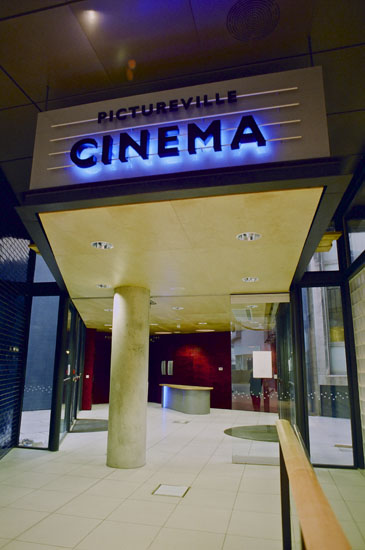 The
1999 Wide Screen Weekend was recently held (March 12 – 15) at the
National Museum of Photography, Film & Television in Bradford,
England. Similar to previous editions, this was the 5th
festival of its kind. Most of the films shown during the busy weekend
were in 70mm and 3-strip Cinerama, two very popular film formats among
the audiences. What follows here is a collection of memories garnished
with some pictures of guests and crew from the Pictureville Cinema. Like
always, many readers of in 70mm – The 70mm Newsletter came to
Bradford in West Yorkshire, England to see wide screen movies. The
1999 Wide Screen Weekend was recently held (March 12 – 15) at the
National Museum of Photography, Film & Television in Bradford,
England. Similar to previous editions, this was the 5th
festival of its kind. Most of the films shown during the busy weekend
were in 70mm and 3-strip Cinerama, two very popular film formats among
the audiences. What follows here is a collection of memories garnished
with some pictures of guests and crew from the Pictureville Cinema. Like
always, many readers of in 70mm – The 70mm Newsletter came to
Bradford in West Yorkshire, England to see wide screen movies.
"Titanic"
A
near-full Pictureville cinema marked the first film show of the Wide
Screen Weekend. "Titanic" was shown in 70mm DTS on
the flat screen. This was the first time it had run in Bradford in 70mm.
Last year it ran in 35mm only. Head of Cinema Mr. Bill Lawrence
introduced the film and declared the weekend open.
"This
is Cinerama"
Saturday
morning marked the monthly return of a widescreen classic, "This
is Cinerama", in the original 3-strip version on the 146
degree, deep curve screen. In the audience that morning were, among
others, Mrs. Jane McLardy (assistant to the Cinerama production manager
on most all the travelogues), Mr. Louis de Rochemont III, director of "Windjammer"
and Ivan Jacobsen.
|
Further in 70mm reading:
Widescreen Weekend 1999
•
Gallery:
1999
• WSW Home
• Through the Years
• The Best of WSW
•
Academy of the WSW
•
Creating the WSW
•
Planning the WSW
• Projecting
the WSW
•
Home of
CINERAMA
•
Projecting CINERAMA
Internet link:
|
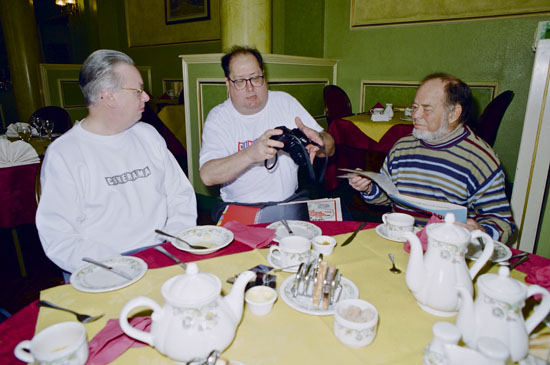 "Windjammer" "Windjammer"
Bill
Lawrence again introduced Louis de Rochemont III and Ivan Jacobsen who
received a standing ovation from the audience. Louis directed "Windjammer"
and Ivan took part in the filming and served as "live"
narrator in Denmark when "Windjammer" was shown during
1958-1959. None of them had seen the film in Cinemiracle in 40 years.
The soundtrack narration of this print is in German, except the songs
which are in English, The print was found a few years ago in a cinema in
Essen, Germany and has gone completely pink over the years. To
compensate for the overall pink look of the film, special filters were
brought in by Mr. Bernard Hedges but to no avail, since some of the
filters were missing when unpacked. The curved screen experience was
overwhelming for many people and I am almost certain that Louis had a
tear in his eyes. Louis signed several autographs after the film. Many
guests had brought along original souvenir programs that turned out to
be a real collectors item with the director’s autograph.
|
|
|
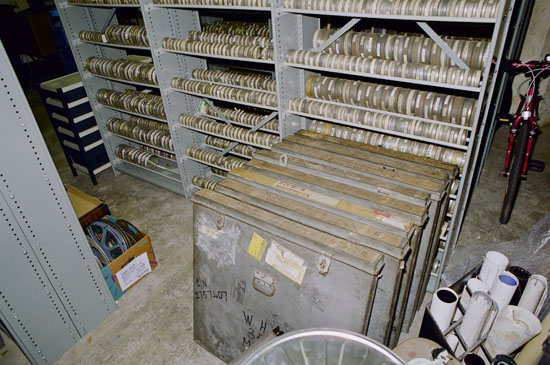 "How the West Was
Won" "How the West Was
Won"
Viewing
"How the West Was Won" on the curved screen is a great
experience. The Technicolor print, despite being from the early sixties,
is excellent. The full color spectrum is still present and I recommend
all to go to see it. The presentation Saturday afternoon was almost a
sell-out. It features an "all-star cast", with many
lesser-known actors and actresses in small "cameo" parts. You
keep asking yourself, "isn’t that…?"
"Ben
- Hur"
After
watching three 3-strip films on one Saturday afternoon with the
ever-apparent join lines, it was a relief, at least to your editor, to
see a completely seamless 70mm picture on the Cinerama curve [Please
read my Cinerama vs. 70mm article in this issue, Editor]. "Ben-Hur"
was introduced with great skill by Mr. Tony Sloman. The print turned out
to be a censored Camera 65 print with the original 1.25x squeeze from
the great 70mm print collection of the Norwegian Film Institute [The
crew at the NFI ought to locate the censored bits and put them back into
the print, Editor]. Although an attempt was made to show the film with
the original Ultra Panavision 70 projection lenses, the print was
ultimately shown without. Amazingly the built-in 1.25X squeeze was not
that objectionable to the human eye. Purists would of course argue the
opposite, but it did not look that bad as the eye got used to the
slightly elongated objects on the screen.
|
|
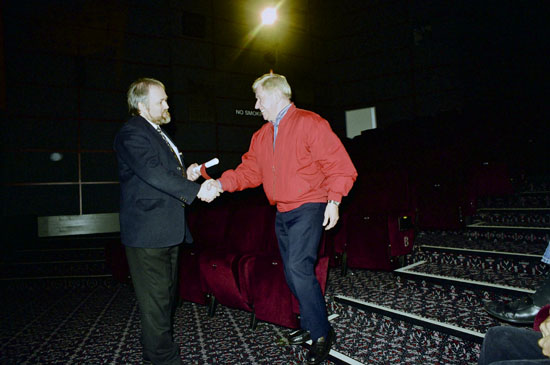 Cineramacana Cineramacana
For the
Early Riser and dedicated 70mm fanatic, Cineramacana Sunday
morning at 10, is THE place to be. You will see assorted reels, often
brought along by the audience themselves (perhaps the only cinema on
earth where an audience not only has to pay for a ticket, but also bring
their own film! But it’s proof of the dedication and devotion of
Pictureville´s 70mm friends), and rare clips of widescreen treasures.
It’s the show with bits and pieces of wide screen treats impossible to
see elsewhere.
For the
second time Cineramacana was also the opportunity to give a nice
round of applause to the projectionists Duncan, Jennifer, Juan and Tony
for their outstanding projection skills and open-minded, helpful and
positive attitude. Cineramacana morning is also when the almost Traditional
Audience on the Stage Picture is done by Bill and your editor. The
picture where the Cineramacana audience is invited on stage in
front of the Cinerama screen to have a group shot taken. A nice souvenir
from the week-end (available and priced very reasonably from your
editor).
This
year a new award was presented to Mr. Howard Rust for his support of
Cinerama (Howard paid for the Cinerama logo on Pictureville´s entrance
door!). Nothing less than the Grand Order of Bradford Film Festival.
A very surprised and happy Howard accepted the prize in the form of a
certificate from Bill.
Here are some of the
other highlights of this year’s Cineramacana:
|
|
|
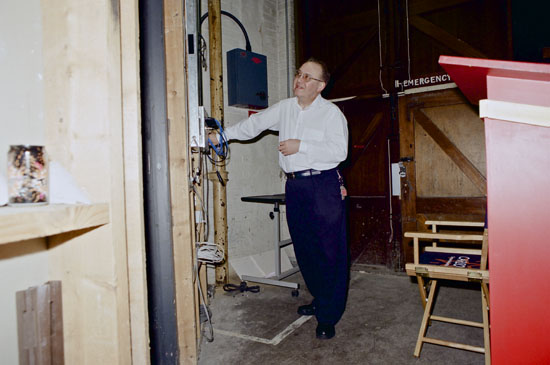 "The
Cinerama Adventure" "The
Cinerama Adventure"
American
director Mr. David Stromeier previewed a 25 minute video, a work in
progress, of "The Cinerama Adventure", a feature
length documentary about Cinerama. A DVD containing a wealth of
supplemental materials and interviews will be available after the
documentary’s general release this summer.
Cinerama
Breakdown Reel
Yet
another fascinating breakdown reel from Cinerama in the 50s. Lowell
Thomas explaining the difficulties of Cinerama. It was a pink 35mm print
shown on the curved screen.
Breakdown
reels were single strip, 35mm, and were only used during the performance
of 3-strip movies in the event of a projection problem that caused a
temporary stop in the performance. A breakdown was a serious matter that
often required re-loading of the 3 projectors and the sound dubber. A
typical repair operation could easily take 10 – 15 minutes, depending
of the nature of the problem.
|
|
|
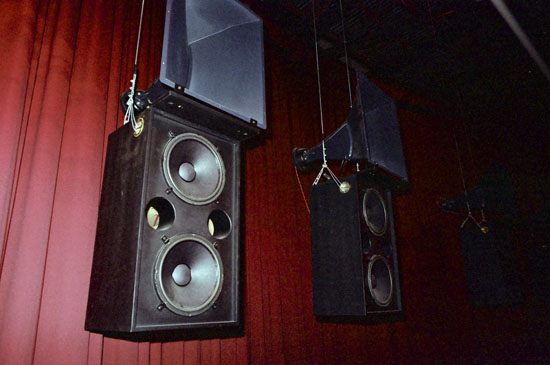 "Philips on
Parade" and "Sky over Holland" "Philips on
Parade" and "Sky over Holland"
Mrs.
Mieke Nijkamp (Parade Cinema in Den Bosh, Holland) introduced the next
couple of films from Holland. The first film was a commercial ad from
Philips known as "Philips on Parade", filmed in 35mm
and blown up to 70mm. The second film was "Sky over
Holland" filmed in MCS-70 Superpanorama. Both films were shown
on the curved screen.
Films from Russia and
East Germany
The
next introduction was given by a former East German resident Mr. Ingolf
Vonau, a Berlin projectionist and frequent visitor to Pictureville.
Thanks to his efforts the audience was given a unique opportunity to see
some rarely seen 70mm footage on the Cinerama curve. The first clip was
from a Russian black and white 70mm production "The Optimistic
Tragedy" (Sovscope 70 1963). The second clip turned out to be
half of the demonstration film "DEFA 70" from 1969. The
short film opened as a mosaic or montage of the same scene filmed from
several different angles until finally becoming a huge giant 70mm
picture. Hopefully Ingolf will have located the rest of the film by next
year. Finally, East Germany’s answer to "2001:A Space
Odyssey", the DEFA 70 production "Signale" in
blazing ORWO color and probably printed on AGFA 70mm stock. Colours on
both "DEFA 70" and "Signale" were
stunning considering the age. Ingolf´s efforts are to be applauded and
soon he will follow up on his DEFA 70 research with an in-depth article
in ..in 70mm - The 70mm Newsletter.
|
|
|
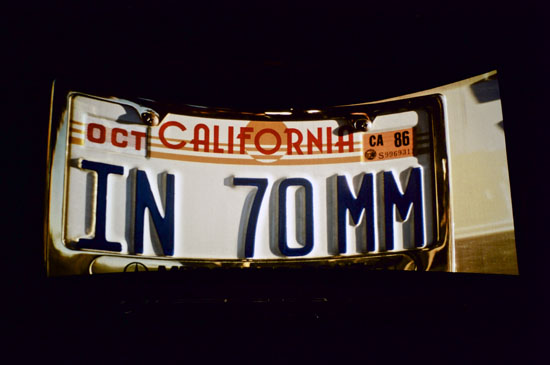 "CineSpace
70 by
Todd-AO" "CineSpace
70 by
Todd-AO"
Introduced
by the editor of …in 70mm – The 70mm Newsletter, the next
short film was also the newest true 70mm film of the whole week-end.
Only 12 years old, but rarely seen. Thanks to Todd-AO in Hollywood,
which provided this print, the audience were given a taste of what
modern 70mm film is. Less than 9 minutes of film, but very dynamic,
filmed in 65mm, 30 frames per second, the "CineSpace 70"
demonstrated just how easily a 65mm camera can be operated. There were
samples of: zoom, steadicam, low light, high speed, slow motion, time
lapse, aerial, under water, exterior, people, nature, daytime,
night-time, extreme wide angle to telephoto etc. After watching
CineSpace 70, there really isn’t any excuse for not using 65mm a lot
more. Although the demonstration film was shot for flat or shallow
curved screens, it turned out very well on the huge Cinerama curve.
Due to
the industry’s lack of interest in 65mm the Todd-AO Camera Division
was closed down a few years ago and all 65mm cameras were mothballed at
Fries Cameras Corp. in Hollywood. The last film photographed with the
CineSpace 70 Todd-AO cameras was the feature-length non-narrative movie "Baraka",
in 1992. Now only Panavision (including the German ARRI 765 camera)
still offers a complete range of 65mm cameras today. Not included here
are all 65mm special effects studios, and Showscan/IWERKS and IMAX, of
course.
The
complete cast/credits of "CineSpace 70"
will be
published in the next issue of …in 70mm – The 70mm
Newsletter.
|
|
|
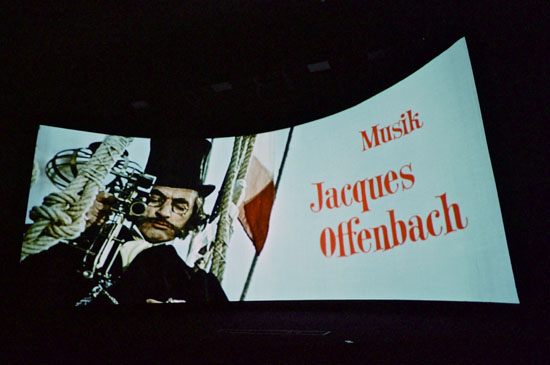 "Renault
Dauphine" "Renault
Dauphine"
The "Renault
Dauphine" is a 3-strip advertisement for the famous Renault
car. The print in Pictureville is slightly faded to a yellowish tint.
The soundtrack is in English. The running time is less than 5 minutes
but it is blended with a wonderful little piece of music. Bill Lawrence
has asked the Renault corporation for permission to screen this film but
has never heard from them. At least they never said "No!".
"Orpheus
in der Unterwelt"
Earlier
Sunday morning, Ingolf had introduced the DEFA 70 format to the audience
in the form of several clips. Introduced next by Ingolf was "Orpheus
in der Unterwelt", the Offenbach operetta filmed in DEFA 70, a
wonderful piece of film that turned out to be "wall to wall
nudity" as Bill Lawrence remarked after the show. One might
expect an older East German film to be somewhat dull and definitely
propagandistic but that was not the case. I found it quite entertaining
on occasion and certainly not boring (much thanks to the nudity of
course).
This
DEFA 70 screening was a rare 70mm treat. Those who missed it on the
Cinerama curve not only missed a rare film in terrific color, which
probably was never screened outside the Iron Curtain, but also missed
the good music mixed wonderfully in 6 track stereo.
|
|
|
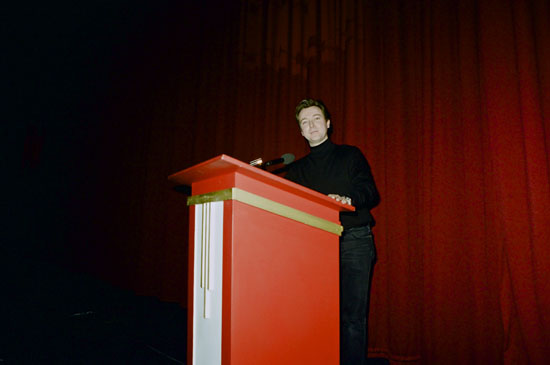 "Grand
Prix" "Grand
Prix"
Introduced
by Tony Sloman "Grand Prix" was shown where it truly
belongs: on the huge curved Cinerama screen. Often criticised for being
boring, "Grand Prix", filmed stunningly in Super
Panavision 70, is probably one of the best front-row experiences, (rivalled
only by "2001:A Space Odyssey") I have ever seen. I
actually moved from the back left side of the theatre to the first row
to enjoy this film. I felt the tension of running high-speed cars when I
caught myself sitting on the edge of the seat. Just wonderful. A truly
first-person experience.
The
70mm print from Norway was faded but it didn’t seem to matter once you
found yourself engulfed in the film. Main titles were designed by the
late Saul Bass. One quite entertaining detail of the film, which I did
find slightly intrusive (except for the racing scenes), were the 65mm
cameras in clear view in the crowd scenes.
"Porgy
and Bess"
Not
seen publicly for the better part of 35 years is "Porgy and Bess"
in Todd-AO. Apparently, the Gershwin estate has opposed public screening
of this film. This year, a rare opportunity to see this film, fresh in
from the Berlin Film Festival, came about. This original early-60s
non-dubbed German 70mm print itself was faded, warped and buckled and
consequently it was shown on the flat screen. To counterbalance the
overall pink film, filters in front of the projection lens were used to
bring back some of the original color spectrum.
|
|
|
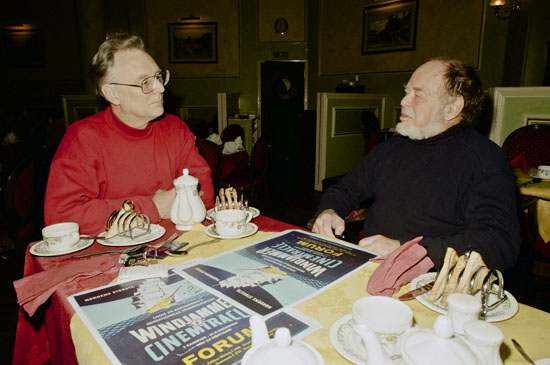 "Song of
Norway" "Song of
Norway"
In
early February I asked Bill what he was showing Monday morning, since my
plane didn’t leave until late afternoon. "What do you want to
see" he asked? I had always heard that "Song of
Norway" was absolute rubbish, but since much of it was filmed
in Denmark, I suggested programming that. The 70mm print was pin sharp
but completely pink, but that is something you come to expect from older
film, and in the end, it’s OK. Its like listening to old 78s. You
expect needle pick-up noise and scratches. Tony, the projectionist
experimented with some filters during the first half. The colours made
it look like an old magazine.
The
film’s second unit action had been directed by none other than Yakima
Canutt, who also directed the chariot race scene in "Ben-Hur"
and stunt scenes in countless Hollywood productions. And sure enough
within the first reel we had two run away horses in the Norwegian Alps. "Ben-Hur"
goes to Norway. It was apparent the cast and crew knew what they were
doing during the filming because there were clear influences from "Sound
of Music" and "My Fair Lady".
I was
happy to have seen it in 70mm and it was certainly not rubbish. A kitsch
classic, perhaps, with its visible wiglines, reflections of camera
equipment, stunt seagulls etc. I was not disappointed. The show on the
Cinerama curve was quite entertaining. It did not make matters worse
that I sat next to Tony Sloman who has a sense of humour which fitted
nicely into the film. So that particular performance was hugely
entertaining, almost like an interactive experience. "Song of
Norway" marked the ending of the 1999 Wide Screen
Weekend with a happy conclusion to perhaps the best Wide Screen Weekend
yet.
|
|
|
|
|
Go: back
- top - back issues
Updated
22-01-25 |
|
|
 "Windjammer"
"Windjammer" Cineramacana
Cineramacana
 The
1999 Wide Screen Weekend was recently held (March 12 – 15) at the
National Museum of Photography, Film & Television in Bradford,
England. Similar to previous editions, this was the 5th
festival of its kind. Most of the films shown during the busy weekend
were in 70mm and 3-strip Cinerama, two very popular film formats among
the audiences. What follows here is a collection of memories garnished
with some pictures of guests and crew from the Pictureville Cinema. Like
always, many readers of in 70mm – The 70mm Newsletter came to
Bradford in West Yorkshire, England to see wide screen movies.
The
1999 Wide Screen Weekend was recently held (March 12 – 15) at the
National Museum of Photography, Film & Television in Bradford,
England. Similar to previous editions, this was the 5th
festival of its kind. Most of the films shown during the busy weekend
were in 70mm and 3-strip Cinerama, two very popular film formats among
the audiences. What follows here is a collection of memories garnished
with some pictures of guests and crew from the Pictureville Cinema. Like
always, many readers of in 70mm – The 70mm Newsletter came to
Bradford in West Yorkshire, England to see wide screen movies. "How the West Was
Won"
"How the West Was
Won" "The
Cinerama Adventure"
"The
Cinerama Adventure" "Philips on
Parade" and "Sky over Holland"
"Philips on
Parade" and "Sky over Holland" "CineSpace
70 by
Todd-AO"
"CineSpace
70 by
Todd-AO" "Renault
Dauphine"
"Renault
Dauphine" "Grand
Prix"
"Grand
Prix" "Song of
Norway"
"Song of
Norway"